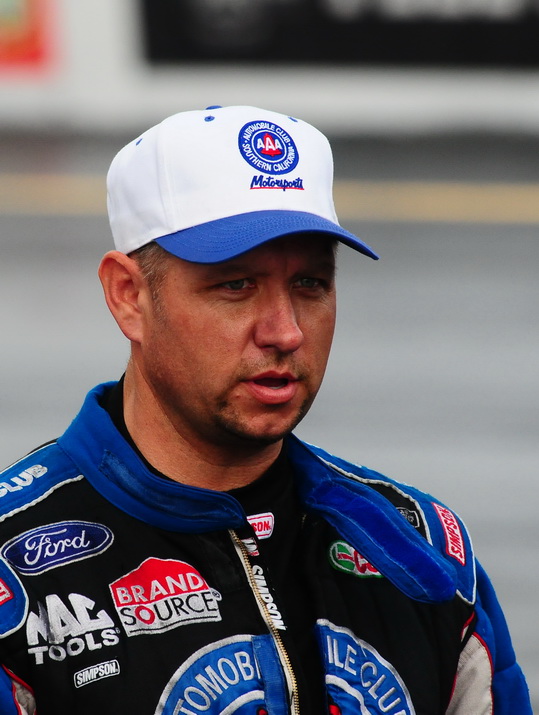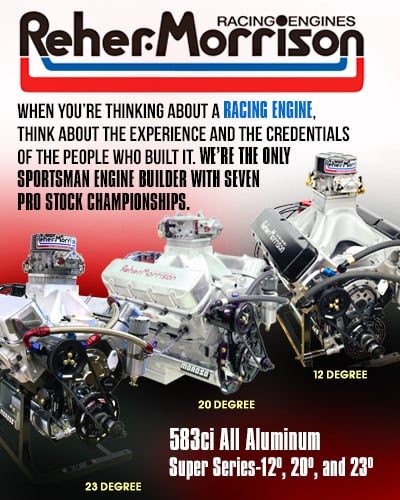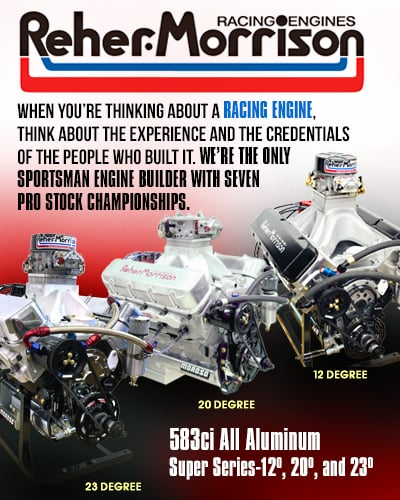NIVER DEATH BRINGS CALL FOR TIGHTER SAFETY STANDARDS
Thu, 2010-07-15 14:00
The voice on the other end of the cell phone line could have belonged to any of the hundreds or thousands of drivers who compete on the NHRA tour in both National and Divisional events on weekly basis. It was a voice of desperation.
How many have to die, was implied in every sentence.
It is a question without an answer.
No one knows how many lives will be lost in the course of the NHRA's history. Have too many been lost already? Yes. Will too many more be lost in the future? Yes. Can the number be reduced by diligent stewards of the sport? Once again, the answer is yes.
How many have to die, was implied in every sentence.
It is a question without an answer.
No one knows how many lives will be lost in the course of the NHRA's history. Have too many been lost already? Yes. Will too many more be lost in the future? Yes. Can the number be reduced by diligent stewards of the sport? Once again, the answer is yes.
By Wednesday evening, calm had returned. Acting quickly, the NHRA issued new rules governing the use of carbon fiber brakes and other devices meant to assist the driver in slowly down the race car, including automatic parachute deployment systems.
The NHRA did not reduce the racing distance from 1320 feet to 1000 feet for the Top Alcohol Dragster and Funny Car classes.
In Seattle, and all other tracks to date, only two top alcohol dragsters were equipped with automatic parachute deployment systems. It should come as no surprise to learn those two dragsters are piloted by Courtney and Brittany Force.
At Eric Medlen's funeral, John Force stood before the attendees and apologized to his fallen driver. He'd “lied” he said, because he had assured Eric he could always trust his race car. “The car will always protect you,” Force told his young protegee. Admittedly, he was proven wrong.
It's not likely anyone lied to Mark Niver. After decades competing in the sport he knew the risks. However, knowing you could die shouldn't relieve either the competitor or the sanctioning body from their respective responsibilities. They are both equally responsible when it comes to safety.
Niver's death is a clear indication something more needs to be done to further ensure the safety of Top Alcohol drivers, both in the dragster and the funny car categories. If the sanctioning body won't make the race car safer then it is incumbent on the car owner, crew chief and/or driver to see something is done.
Force didn't wait for the sanctioning body.
Bob Tasca, a former Top Alcohol Funny Car driver, licensed Pro Stock driver and now in his third year driving the Quick Lane Ford Mustang Funny Car, bordered between sadness and serious anger as he discussed the death of Niver on Tuesday afternoon and what the tragedy means to the sport.
“Changes are needed,” Tasca stated emphatically, before reeling off a list of immediate changes he would implement to make the race cars safer, including a move to 1000 foot racing.

“When things go wrong, there is no greater gift or safety invention you can give a driver than 320 feet. That is critical, when all things go wrong.”
Not by chance, every mechanical improvement on Tasca's list is in use on two prominent Top Alcohol dragsters – those of Courtney and Brittany Force. However, the NHRA stopped short of his recommendations, allowing the Alcohol ranks to continue to race to the quarter mile mark.
Their dragsters, according to Force, are equipped with all the same safety features which exist on older sister Ashley's Funny Car. Equipment which was available, but not in place, on Niver's dragster. Force wasn't taking a stab at Niver. Until Wednesday evening, July 14th, there were no rules requiring carbon fiber brakes, automatic shut-offs, and the like on Top Alcohol Dragsters and Top Alcohol Funny Cars. In fact, until the NHRA's latest mandate, Top Fuel Funny Car teams could still use steel brakes on the front wheels. That fact alone shocked Bob Tasca. He was of the understanding carbon fiber was mandated on all four wheels, already.
Both Bob Tasca and Jack Beckman have history in the Top Alcohol Funny Car ranks. Both believe they are safer in their current fuel Funny Cars, despite the higher speeds, than they ever were in the Top Alcohol Funny Car.
“Without a doubt,” confirmed Tasca. “I am safer now than I was just two years ago in my Top Fuel Funny Car,” he added. “Would I want to drive the car I was in when I first broke into Top Fuel? No. Not with what we know today. Don't forget, I've lived through this. The car we have today is so much safer then the car we ran just two years ago.”
At least on Tuesday, Tasca was certain he would never want to get back behind the wheel of a Top Alcohol Funny Car. Not under the rules at the time. With the mandated changes his attitude could change.
Jack Beckman, another Top Alcohol alum and driver of the Mail Terminal Services/Valvoline Dodge Funny Car, on the same Tuesday, said he would drive a Top Alcohol Funny Car again.
“Would I drive one?” said Beckman, repeating the question. “Absolutely. As drivers we have to feel a sense of invulnerability.”
Beckman believes Niver felt that same sense of invulnerability, which is why he continued to drive even at age 60. Niver was a man Beckman called friend.
“I've actually raced him and had the pleasure of being beaten by Mark,” Beckman said with a sense of deep respect in his voice. “Did you ever meet him? He was just the best guy. He was the kind of guy everybody loved.”
Despite his respect for Niver, Beckman candidly admitted there is always the chance the driver is culpable in these situations.
“People are quick to blame safety equipment. But, I don't know,” Beckman said. “Mark was the kind of guy you couldn't say enough good about. But, did he have carbon fiber brakes? Was his car as safe as it could be? I don't know.”
Beckman was certain of one fact, despite the death of Niver and Neal Parker, 58, at Englishtown, there isn't a compelling reason to reduce those cars to 1000 foot racing.
“Those cars are running no faster today than they were in the '90s,” Beckman said, explaining why he felt there was no compelling need to shorten their racing distance. “Should other things be done first? Yes. Carbon fiber brakes, automatic shut-offs; those types of changes should be looked at first.”

It was almost as if Beckman was looking into a crystal ball. Two days later, when the NHRA issued the rules amendment, a reduction to 1000 foot racing was nowhere to be found.
Lost in the shock of losing Niver, is the fact Courtney Force wrecked her Top Alcohol Dragster on Saturday. She walked away from the crash with only a “headache” according to her father, because he insists his daughter's race cars be held to the same safety standard as his own Funny Car.
All of the changes mandated on Wednesday afternoon by the NHRA are already in place on Courtney and Brittany's cars. Still, following Courtney's wreck, Force will have her chassis examined with a fine tooth comb. The chassis might even end up at Ford for analysis.
Force goes beyond having the best equipment possible on his race cars. He also gives his daughters a very valuable piece of advice.
“I've told them that if you get in trouble in the race car, if the brakes or the parachutes aren't working, put the car into the wall.”
Force isn't suggesting they drive head on into the wall. However, he does believe it is better to scrub off speed by scraping the wall then it is to rely entirely on the sand traps and catch fences at the far end of the drag strip.
Robert Hight, driver of the Auto Club Ford owned by John Force Racing, was involved with the upgrades to Courtney and Brittany's race cars, who initially were SuperComp racers before the two graduated to Top Alcohol dragsters Cars.
And, because of his close work with Ford after Force was nearly killed in Dallas on September 24th of 2007, Hight can speak with confidence about how much affect the newly mandated safety features will have in the Alcohol ranks.
“I am pretty sure the Funny Car we drive today is at least seven times stronger than what we were driving just two years ago,” Hight stated. “Since Funny Car started the horsepower had gone from 1200 to 8000 without any basic changes to the chassis.”
Hight believes it is probably time to look hard at the chassis under the Top Alchohol Dragster and Funny Car, in the same way the Top Fuel Funny Car chassis was made over.
There is only one man who knew for certain what happened on Sunday morning at Pacific Raceway and unfortunately he can't speak to us. But, his car can talk and every driver willing to talk says it is imperative to learn everything possible from the remains of Niver's chassis in the hopes of increasing the number of drivers who can one day sit back in their rocking chair and remember the good ole days of drag racing.
How many have to die, was implied in every sentence.
It is a question without an answer.
No one knows how many lives will be lost in the course of the NHRA's history. Have too many been lost already? Yes. Will too many more be lost in the future? Yes. Can the number be reduced by diligent stewards of the sport? Once again, the answer is yes.
The voice on the other end of the cell phone line could have belonged to any of the hundreds or thousands of drivers who compete on the NHRA tour in both National and Divisional events on weekly basis. It was a voice of desperation.

Bob Tasca, a former Top Alcohol Funny Car driver, licensed Pro Stock driver and now in his third year driving the Quick Lane Ford Mustang Funny Car, bordered between sadness and serious anger as he discussed the death of Niver on Tuesday afternoon and what the tragedy means to the sport.
How many have to die, was implied in every sentence.
It is a question without an answer.
No one knows how many lives will be lost in the course of the NHRA's history. Have too many been lost already? Yes. Will too many more be lost in the future? Yes. Can the number be reduced by diligent stewards of the sport? Once again, the answer is yes.
By Wednesday evening, calm had returned. Acting quickly, the NHRA issued new rules governing the use of carbon fiber brakes and other devices meant to assist the driver in slowly down the race car, including automatic parachute deployment systems.
The NHRA did not reduce the racing distance from 1320 feet to 1000 feet for the Top Alcohol Dragster and Funny Car classes.
In Seattle, and all other tracks to date, only two top alcohol dragsters were equipped with automatic parachute deployment systems. It should come as no surprise to learn those two dragsters are piloted by Courtney and Brittany Force.
At Eric Medlen's funeral, John Force stood before the attendees and apologized to his fallen driver. He'd “lied” he said, because he had assured Eric he could always trust his race car. “The car will always protect you,” Force told his young protegee. Admittedly, he was proven wrong.
It's not likely anyone lied to Mark Niver. After decades competing in the sport he knew the risks. However, knowing you could die shouldn't relieve either the competitor or the sanctioning body from their respective responsibilities. They are both equally responsible when it comes to safety.
Niver's death is a clear indication something more needs to be done to further ensure the safety of Top Alcohol drivers, both in the dragster and the funny car categories. If the sanctioning body won't make the race car safer then it is incumbent on the car owner, crew chief and/or driver to see something is done.
Force didn't wait for the sanctioning body.
Bob Tasca, a former Top Alcohol Funny Car driver, licensed Pro Stock driver and now in his third year driving the Quick Lane Ford Mustang Funny Car, bordered between sadness and serious anger as he discussed the death of Niver on Tuesday afternoon and what the tragedy means to the sport.
“Changes are needed,” Tasca stated emphatically, before reeling off a list of immediate changes he would implement to make the race cars safer, including a move to 1000 foot racing.

Jack Beckman believes he is safer in a fuel Funny Cars, despite the higher speeds, than he ever was in the Top Alcohol Funny Car.
“When things go wrong, there is no greater gift or safety invention you can give a driver than 320 feet. That is critical, when all things go wrong.”
Not by chance, every mechanical improvement on Tasca's list is in use on two prominent Top Alcohol dragsters – those of Courtney and Brittany Force. However, the NHRA stopped short of his recommendations, allowing the Alcohol ranks to continue to race to the quarter mile mark.
Their dragsters, according to Force, are equipped with all the same safety features which exist on older sister Ashley's Funny Car. Equipment which was available, but not in place, on Niver's dragster. Force wasn't taking a stab at Niver. Until Wednesday evening, July 14th, there were no rules requiring carbon fiber brakes, automatic shut-offs, and the like on Top Alcohol Dragsters and Top Alcohol Funny Cars. In fact, until the NHRA's latest mandate, Top Fuel Funny Car teams could still use steel brakes on the front wheels. That fact alone shocked Bob Tasca. He was of the understanding carbon fiber was mandated on all four wheels, already.
Both Bob Tasca and Jack Beckman have history in the Top Alcohol Funny Car ranks. Both believe they are safer in their current fuel Funny Cars, despite the higher speeds, than they ever were in the Top Alcohol Funny Car.
“Without a doubt,” confirmed Tasca. “I am safer now than I was just two years ago in my Top Fuel Funny Car,” he added. “Would I want to drive the car I was in when I first broke into Top Fuel? No. Not with what we know today. Don't forget, I've lived through this. The car we have today is so much safer then the car we ran just two years ago.”
At least on Tuesday, Tasca was certain he would never want to get back behind the wheel of a Top Alcohol Funny Car. Not under the rules at the time. With the mandated changes his attitude could change.
Jack Beckman, another Top Alcohol alum and driver of the Mail Terminal Services/Valvoline Dodge Funny Car, on the same Tuesday, said he would drive a Top Alcohol Funny Car again.
“Would I drive one?” said Beckman, repeating the question. “Absolutely. As drivers we have to feel a sense of invulnerability.”
Beckman believes Niver felt that same sense of invulnerability, which is why he continued to drive even at age 60. Niver was a man Beckman called friend.
“I've actually raced him and had the pleasure of being beaten by Mark,” Beckman said with a sense of deep respect in his voice. “Did you ever meet him? He was just the best guy. He was the kind of guy everybody loved.”
Despite his respect for Niver, Beckman candidly admitted there is always the chance the driver is culpable in these situations.
“People are quick to blame safety equipment. But, I don't know,” Beckman said. “Mark was the kind of guy you couldn't say enough good about. But, did he have carbon fiber brakes? Was his car as safe as it could be? I don't know.”
Beckman was certain of one fact, despite the death of Niver and Neal Parker, 58, at Englishtown, there isn't a compelling reason to reduce those cars to 1000 foot racing.
“Those cars are running no faster today than they were in the '90s,” Beckman said, explaining why he felt there was no compelling need to shorten their racing distance. “Should other things be done first? Yes. Carbon fiber brakes, automatic shut-offs; those types of changes should be looked at first.”

Robert Hight, driver of the Auto Club Ford owned by John Force Racing, was involved with the upgrades to Courtney and Brittany's race cars, who initially were SuperComp racers before the two graduated to Top Alcohol Funny Cars.
It was almost as if Beckman was looking into a crystal ball. Two days later, when the NHRA issued the rules amendment, a reduction to 1000 foot racing was nowhere to be found.
Lost in the shock of losing Niver, is the fact Courtney Force wrecked her Top Alcohol Dragster on Saturday. She walked away from the crash with only a “headache” according to her father, because he insists his daughter's race cars be held to the same safety standard as his own Funny Car.
All of the changes mandated on Wednesday afternoon by the NHRA are already in place on Courtney and Brittany's cars. Still, following Courtney's wreck, Force will have her chassis examined with a fine tooth comb. The chassis might even end up at Ford for analysis.
Force goes beyond having the best equipment possible on his race cars. He also gives his daughters a very valuable piece of advice.
“I've told them that if you get in trouble in the race car, if the brakes or the parachutes aren't working, put the car into the wall.”
Force isn't suggesting they drive head on into the wall. However, he does believe it is better to scrub off speed by scraping the wall then it is to rely entirely on the sand traps and catch fences at the far end of the drag strip.
Robert Hight, driver of the Auto Club Ford owned by John Force Racing, was involved with the upgrades to Courtney and Brittany's race cars, who initially were SuperComp racers before the two graduated to Top Alcohol dragsters Cars.
And, because of his close work with Ford after Force was nearly killed in Dallas on September 24th of 2007, Hight can speak with confidence about how much affect the newly mandated safety features will have in the Alcohol ranks.
“I am pretty sure the Funny Car we drive today is at least seven times stronger than what we were driving just two years ago,” Hight stated. “Since Funny Car started the horsepower had gone from 1200 to 8000 without any basic changes to the chassis.”
Hight believes it is probably time to look hard at the chassis under the Top Alchohol Dragster and Funny Car, in the same way the Top Fuel Funny Car chassis was made over.
There is only one man who knew for certain what happened on Sunday morning at Pacific Raceway and unfortunately he can't speak to us. But, his car can talk and every driver willing to talk says it is imperative to learn everything possible from the remains of Niver's chassis in the hopes of increasing the number of drivers who can one day sit back in their rocking chair and remember the good ole days of drag racing.
Categories:




































